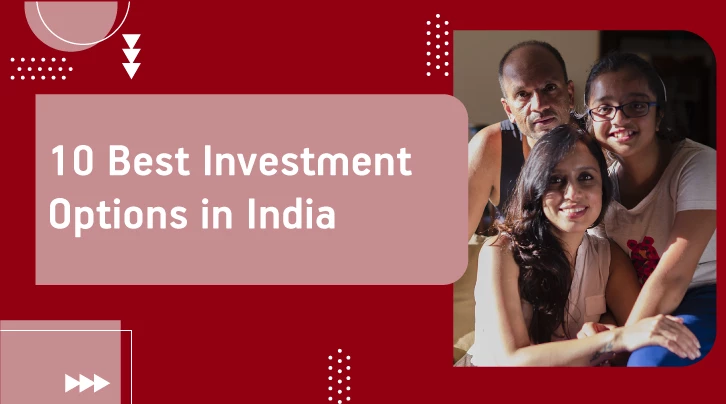Confused about all the various investment options available in India? Read this post to learn more about 10 popular investments and how you can choose from the options available.
Investment awareness is at an all-time high in India. Slowly but steadily, people have started recognizing the critical role investments can play in their lives. But just like the number of people looking to invest, the investment options are growing too.
If you want to begin your investment journey but are confused about where you should begin, here’s a list of the top 10 investments with handy tips on making the selection-
10 Best Investment Options in India
Equity/Stocks
Investing in the stock market can be highly rewarding. However, as the asset class also carries the highest level of risk, ensure you choose direct equity investment only after gaining some knowledge and experience. Most importantly, like any other investment, you should make an equity investment in line with your financial goals and risk appetite.
Mutual Funds
Mutual funds are a collective investment vehicle where funds from several investors are invested as per the scheme's objective. Various types of mutual funds, including equity, debt, hybrid, ELSS, index, and more, are available to suit every investor's financial goals and risk profile.
Bank Deposits
If you’re a risk-averse investor, bank deposits like Fixed Deposits (FDs) and Recurring Deposits (RDs) can be one of the best investment ideas for you. The deposit accounts generate fixed returns over a fixed tenure.
Unit Linked Insurance Plan (ULIP)
ULIPs combine life insurance with investment. The premiums you pay for a ULIP are divided into life insurance premiums and investments in your preferred financial instruments. Moreover, under Section 80C of the IT Act, premiums of up to Rs. 1.5 lakhs paid towards ULIP are eligible for tax deductions.
Real Estate
Real estate is one of the traditionally popular investment options in India. While real estate investment can be rewarding, the high property costs in most parts of the country make it an unsuitable choice for most new investors.
Sovereign Gold Bond (SGB)
SGB is an initiative by the RBI to provide Indians with a digital alternative to physical gold. SGB investments come with a maturity of 8 years with the option to exit after the 5th year. Your investment in SGB generates interest income. Moreover, you can also benefit from the appreciation of gold prices between the purchase and redemption date.
Public Provident Fund (PPF)
If you’re looking for the best investment options in India for a longer timeframe, PPF can also be an excellent choice. The government-backed investment option comes with a lock-in period of 15 years, during which investors earn compound interest at the rate fixed by the government.
Post Office Savings Schemes
India Post also offers various investment options, like Post Office Savings Account, Post Office Time Deposit Account (TD), Monthly Income Scheme (MIS), and more. If you want to build a habit of saving and generating low-risk returns, visit the nearest post office to explore the available options.
Senior Citizen Savings Scheme (SCSS)
Individuals above 60 years looking for the investment options can consider investing in the government-backed SCSS. With a maturity of 5 years which can be extended by up to 3-years, and a competitive interest rate, SCSS can be ideal for seniors to generate low-risk and fixed returns.
National Pension Scheme (NPS)
If you want to invest toward your retirement goal, you can consider investing in NPS. It is a government-backed voluntary savings scheme where the investment matures once the investor turns 60. On maturity, if the corpus is above Rs. 5 lakhs, 60% of the amount can be withdrawn. The remaining 40% is annuitized.
Which Investment Option is Right for You?
Now that you have a list of the 10 investment options in India, it is time to make a selection. Focus on these three factors to make a decision-
Investment Objective
Every investment should have a fixed objective or goal. For example, the most common investment objectives are purchasing a home, building a retirement corpus, a child's higher education and marriage, and a secondary source of income.
Investment Tenure
The investment should also be made for a fixed tenure, depending on your objectives. For instance, it could be purchasing a home in the next 10 years or investing for retirement, which is 20-30 years away.
Risk Appetite
Last but not least is your risk appetite. The risk appetite is the amount of risk you’re willing to take to generate the expected returns. Investment options like equity and equity mutual funds are ideal for risk-seeking investors. However, if you’re risk-averse, you can stick to safer options such as debt funds, FDs, or government-backed schemes, etc.
Making an Informed Investment Decision
Based on the list of top investment options and factors to choose an investment, you should be able to make an investment decision. But before investing, ensure you thoroughly understand the investment you’ve selected, especially aspects like risk profile, returns history, and maturity period (if applicable).
If you’re new to investments and finding the selection difficult, consult an investment advisor before investing.
Mutual Fund investments are subject to market risks, read all scheme related documents carefully.





 1800-270-7000
1800-270-7000




